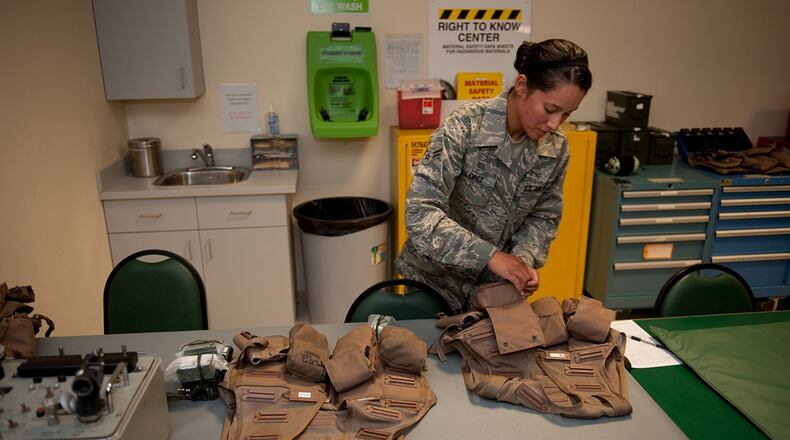The CRA program, which is modeled after the U.S. Army’s PEO Soldier program, performs three overarching tasks to achieve its mission. It ensures funding is available, communicates with Air Force functional communities concerning their Airmen’s OCIE requirements and coordinates with the Air Force Life Cycle Management Center to have those needs met prior to issuing the finished products to the functional communities.
Michael Brown, a contractor in AFMC’s CRA program office, said the CRA program ensures Airmen who are newly assigned to an installation have all of the OCIE they need to carry out their day-to-day duties in support of the mission.
Brown added that this also applies to deployed locations. They must ensure that Airmen performing duties while overseas have the necessary modern gear to operate in their assigned area of responsibility.
The CRA program evolved from U.S. Air Force Chief of Staff Gen. David Goldfein’s request that asked the Air Force to develop a CRA program. Goldfein has also encouraged the creation of uniforms and gear that fit better and are more comfortable and suitable for both male and female Airmen to perform their mission-related duties.
In 2017, the program started seeing more traction with gender-specific product modification requests before standing up officially. Some of the outcomes of those requests were redesigned gear and flight suits for female aircrew Airmen.
The CRA program officially stood up in 2019 and extends those services received by aircrew and special warfare Airmen to all Airmen, regardless of their career fields. Since standing up, the CRA team has already begun tackling OCIE requests.
Brown said the Air Force, similar to other military services, was struggling with providing gender-specific OCIE products, like female body armor.
He added that Goldfein challenged the CRA team to find a solution for the female body armor issue last year. After coordinating with Wright-Patterson Air Force Base’s Security Forces Airmen and teaming up with the Air Force Security Forces functional community, the CRA team developed a piece of body armor equipment specifically designed to fit the bodies of female Airmen better than the armor currently used.
Brent Van Dyk, also a contractor on AFMC’s CRA team, said that only Airmen working in special warfare and flight crew career fields, which are only about 9% of the Air Force’s Airmen, had a program office that was able to support their OCIE needs prior to the CRA program office launching.
According to the CRA team, that means that the other 91% of Airmen who were working in other fields were left without an advocate other than their functional communities when it came to their OCIE needs. By not having a central program office previously, those other Air Force functional communities handled their own requests individually and not necessarily uniformly.
Now that a central program office has been established, OCIE can be standardized for functional communities across the Air Force.
The CRA team said that having a central program office also allows the level of effort and financial burden to be shifted from a unit to a single program designed to address present and future critical OCIE issues.
OCIE requests are coordinated with AFLCMC for research and development, testing and evaluation before they are issued to the functional communities for distribution.
By successfully executing OCIE requests, the CRA team members said they seek to gain leadership’s trust and show Airmen that the products created are with their best interest in mind.
The CRA team added that support from Air Force leaders is vital to the CRA program because it needs full support from leadership at all levels to be successful. The team also believes that utilization of the program by leaders will standardize the force and build esprit de corps throughout the Air Force.
For more information about the CRA program or how to request OCIE, contact Felicia Hamilton by calling 937-257-8130.
About the Author
